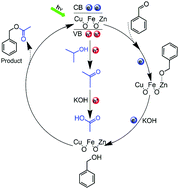Zinc-triggered photocatalytic selective synthesis of benzyl acetate on inverse spinel CuFe2O4 3D networks: a case of coupled redox photocatalytic reaction†
Abstract
Coupled redox photocatalytic (CRP) reactions are a concept in which reduction and oxidation products are further reacted and serve as each other's redox partners. Herein, we developed a Zn-doped CuFe2O4 3D network for the CRP reaction to generate benzyl acetate with high selectivity. The ammonia assisted sol–gel method helps to improve the specific surface area of inverse spinel CuFe2O4 and therefore the concentration of oxygen vacancies. With an optimized doping content of 0.5%, Zn-doped CuFe2O4 presents a photocurrent as high as 34.72 µA cm−2, which indicates that Zn-doping largely boosts the charge separation efficiency in accordance with the surface photovoltage measurement. Most importantly, in the CRP reaction, zinc triggers the selectivity of benzaldehyde to benzyl acetate from 2.97% to 74.80%. Density functional theory (DFT) calculations further reveal that zinc doping enhances the adsorption energy of the intermediate product of acetone in CuFe2O4-based CRP reaction leading to enhanced activity and selectivity.



 Please wait while we load your content...
Please wait while we load your content...